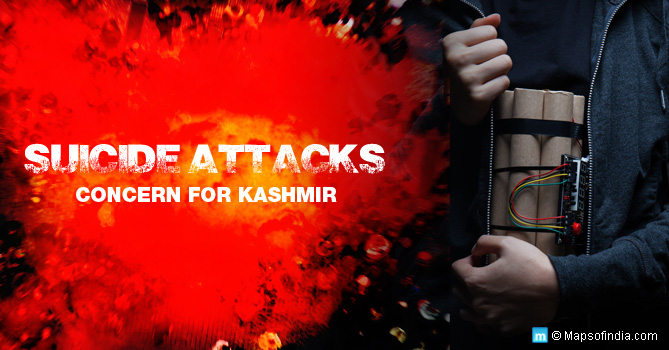Ever since its inclusion in the Indian Union, Kashmir has always been a major issue for the Indian Government, which in its own part has tried various means to stem the rot. Cross-border terrorism, said to emanate from Pakistan, has also contributed to the headaches of the central administration with plenty of suicide attacks to boot in the last few years. Most of these have been aimed at administrative powers with the aim of ‘freeing’ Kashmir from the clutches of India. The methods of execution may have been different but the basic aim has been the same – to make a statement that makes everyone sit up and take note.
Combating suicide attackers can present some interesting challenges for the soldiers considering the fact that they prefer to die rather than escape and they are well-trained enough to keep dodging till the time they reach their target.
2001 suicide attack
The 2001 suicide attack was targeted at the legislative assembly of Jammu and Kashmir. It happened on 1 October, a Monday, and the militants were members of Jaish-e-Mohammed at Srinagar. A Tata Sumo was used to execute the attack by filling it up with explosives and then using three fidayeen suicide bombers to strike the main gate. The three bombers, as well as 38 others, lost their lives in this attack. The attack happened at 14:00 hours, which is an hour after proceedings conclude for the day. No legislator was killed in the attack.
Suicide attacks in 2001 and 2002
Experts feel that the trend of suicide attacks in Kashmir started after Pakistan was forced to backtrack in the Kargil War. The first such attack took place in August 1999, thus making it a relatively-new phenomenon as far as strategies used by terrorists are concerned. Lashkar-e-Taiba (LeT) fighters attacked an outpost of Border Security Force (BSF) at Kupwara district and blew themselves up in the process. At that time it was said that the LeT fighters simply shifted their base from Kargil to Kashmir Valley. After that, around 29 suicide operations had taken place in 2001 followed by almost 21 in 2002.
Suicide attacks in 2015
On 20 March a group of fidayeen, dressed in Army uniform, hit a police station at Kathua district and killed seven people. This included three Special Forces officers and a couple of militants. 12 people were injured. The authorities recovered a couple of AK-47s with 156 rounds and 21 magazines, 19 live grenades, a couple of wire cutters, and a couple of pistols with 61 rounds.
On the very next day, a group of fidayeen militants attacked an Army camp, located on Jammu-Pathankot National Highway at Samba district. Three people were injured in the attack. On 31 May fidayeen bombers attacked a Brigade headquarters at Tanghdar sector, Kupwara district. There were six terrorists in all and they were heavily armed. However, the Army was able to stop them in the tracks by killing four participants. In all, five people were killed in the confrontation between the militants and armed forces. The Army had to use 40 elite Commandos who belonged to 4-Para stationed in Kupwara to combat the militants.
On 25 November, a generator operator, employed with MES, and three militants of Jaish-e-Mohammed (JeM) lost their lives in an encounter between the Army and fidayeen bombers who were well armed. The attack took place in the vicinity of the Line of Control (LOC) at Tanghdar, Kupwara, in North Kashmir. A couple of army officers were injured and infrastructure including barracks, kerosene depot, and vehicles were damaged even as the fight raged for hours. According to pouches recovered from the dead militants they proclaimed to be members of Afzal Guru Brigade.
On 7 December, militants – once again dressed in Army uniforms – opened fire on a CRPF convoy and injured six soldiers. The incident took place close to the Green Tunnel, Bijbehara, Anantnag district in South Kashmir. The first few vehicles were allowed to go by the militants who aimed their fire at two vehicles in the convoy and then escaped to take cover in the dense trees located nearby. The incident took place at around 10:00 hours. The authorities said a possible bigger attack was thwarted by the CRPF Road Opening Patrol that had been deployed on the said highway. Dr Abdullah Ghaznavi, the LeT spokesman, claimed responsibility for the attacks later on.
On the very next day the CRPF had a short shootout with fidayeen militants at Pampore in Pulwama, and were able to kill a couple of them. One of the militants was Shakir Showkat Bhat, who was a resident of Nowpara, Sopore, and whose father was named Showkat Ahmad Bhat. The other terrorist was a foreign national. It was said that both of them had carried out the previous day’s attack on the CRPF convoy and on 8th they were supposed to carry out a suicide attack in Srinagar before a Special Forces joint team intercepted and foiled their efforts.






